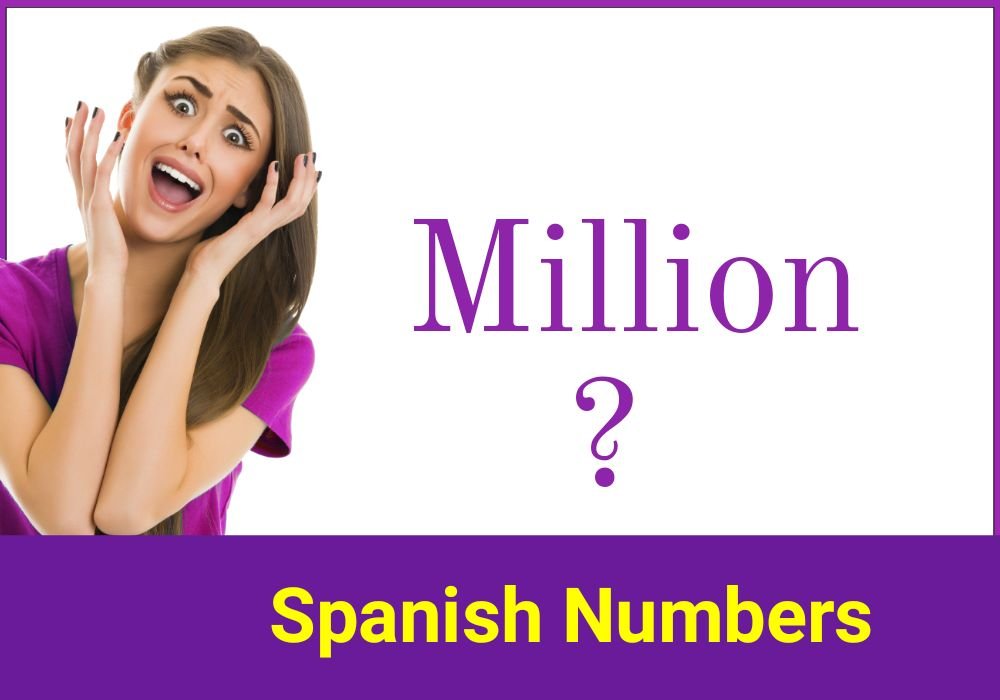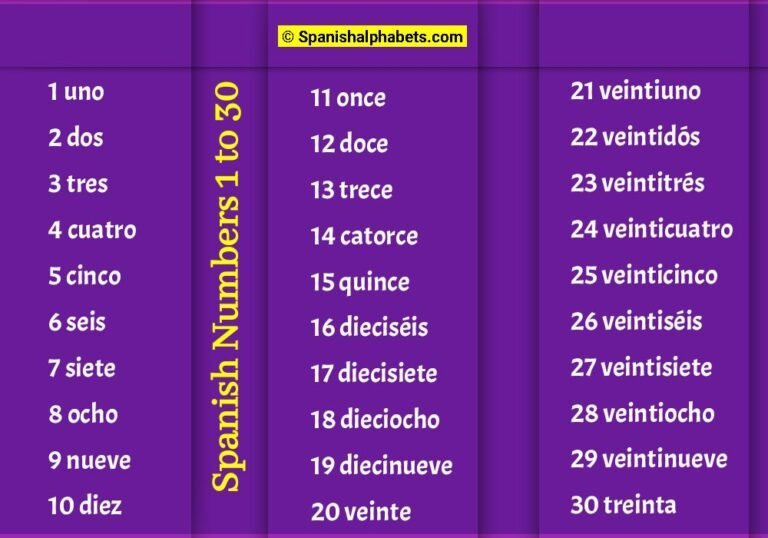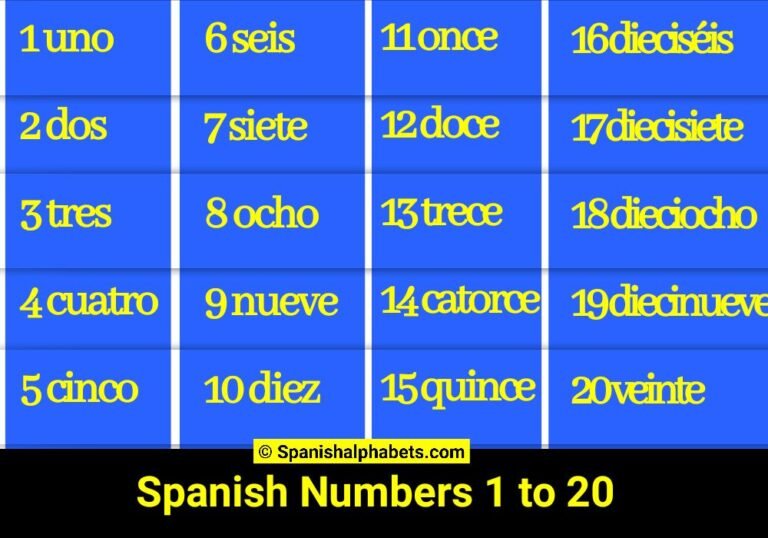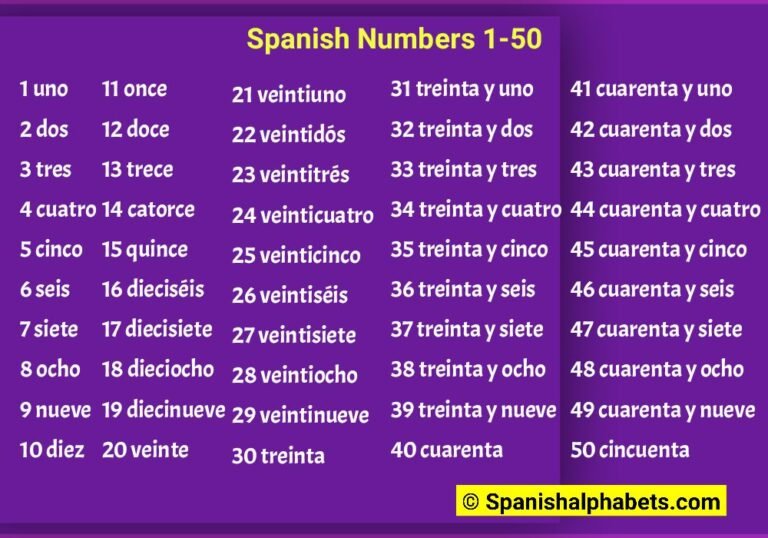Spanishalphabets.com is one of the best blogs for learning the Spanish language.
On this page, you can learn from 1,000 to 1 million how the Spanish number system works.
This blog provides concise and easy-to-understand explanations of the rules of the Spanish number system, complete with examples.
After reading this blog, you can confidently use numbers in Spanish conversation and writing.
The Spanish number system is based on the decimal system and uses the following symbols: 0, 1, 2, 3, 4, 5, 6, 7, 8, 9.
These numbers are combined to form more significant numbers. For example, the number 12 can be formed by combining the symbols 1 and 2.
Similarly, the number 123 can be formed by combining the symbols 1, 2, and 3.
Learn How to Count to a Million in Spanish
Counting to a million in Spanish is relatively simple compared to other languages. The number system is based on units of tens, so you only need to learn the numbers from 1-10 and then combine them accordingly.
For example, the number 11 in Spanish is pronounced “once,” which is literally “one-ten.”
From there, you can break down the numbers into manageable chunks and combine them to form more significant numbers.
Counting to a million in Spanish is easier than it may seem at first. With some practice, you can quickly learn how to count to a million. Here are a few tips to help you get started:
- Start by learning the numbers 1-10. Once you know these, you can begin counting up from there.
- Pay attention to the way that numbers are written in Spanish. For example, the number 21 would be written as veintiuno, not ventuno.
- Practice counting out loud until you feel confident with the numbers. You can also try writing them down to solidify your understanding.
- When you get to 100,000, remember it is written as cien mil in Spanish.
From Thousands to Millions: Mastering Spanish Numbers
Spanish numbers might seem confusing at first, but with some practice, you can master them quickly. Here are some tips to help you get started.
One way to remember Spanish numbers is to group them into sets of three. For example, the numbers 1-3 are all single digits, 4-6 are all double digits and 7-9 are all triple digits.
This can help you when you’re trying to read or write more extended numbers.
Another helpful tip is to use mental shortcuts when you can. For instance, knowing that 10 is diez and 100 is cien will help you quickly calculate more significant numbers like 1,000 (mil) and 1,000,000 (un million).
With some practice, you can confidently read and write Spanish numbers of any size!
1000 to 1 Million: What Do These Numbers Mean in Spanish?
In Spanish, the numbers 1000 to 1 million are said as follows: mil, dos mil, tres mil, cuatro mil, cinco mil, seis mil, siete mil, ocho mil, nueve mil; un millón. The numbers from 100 to 999 are said just as they are in English.
However, when saying a number like 1234 in Spanish, you would say it as “mil doscientos treinta y cuatro” instead of “one thousand two hundred thirty-four.” So what do all of these numbers mean in Spanish?
Mil means 1000 and is the most common way to say thousand in Spanish. You will hear this word used often to describe large sums of money.
For example: compré un coche por diezmil euros. I bought a car for 10 thousand euros.
How to Pronounce Spanish Numbers 1000 to 1 Million
Spanish numbers 1000 to 1 million may seem daunting initially, but with some practice, they’re easy to pronounce. Here are some tips to help you get started:
To pronounce numbers 1000-9999, combine the words for the hundreds, tens, and ones.
For example, 1000 is diez mil, 1010 is diez un mil, 1234 is doce mil trescientos cuarenta y cinco.
The word for 100,000 is cien mil. To form numbers more significant than 100,000, add the number of hundreds of thousands after cien mil. For example, 200,000 is doscientos mil, 300,000 is trescientos mil, 1 million is un millón.
To pronounce numbers greater than 1 million, add the appropriate number of millions after un millón.
You Won’t Believe How Different Spanish Numbers Are from English Numbers
You might think learning Spanish numbers is as easy as one, two, or three—but you’d be wrong. Spanish numbers are pretty different from their English counterparts. For one thing, the way they’re used is different.
In Spanish, the number two indicates a pair of something, whereas, in English, it’s generally used to mean a quantity of two.
Moreover, how numbers are said aloud often differs in Spanish from English. We typically say “twenty-one” in English as “two ten one.” But in Spanish, this would be “veintiuno”—literally “twenty-one.”
Finally, some numerical differences between the two languages can trip up even the most seasoned language learner. Take the number 80, for example.
Why Spanish is the most complex language for Americans to learn
Spanish is widely considered one of the most complex languages for English speakers to learn.
There are many reasons for this, but some of the main ones are that Spanish has a different alphabet and pronunciation and complicated grammar rules.
One of the biggest challenges for English speakers learning Spanish is the alphabet. While both languages use the Latin alphabet, Spanish has 27 letters, while English only has 26.
This might seem like a slight difference, but it can make a significant impact when trying to read or pronounce words.
Additionally, how letters are pronounced in Spanish often differs from how they sound in English.
For example, the letter “c” is pronounced like an “s” in Spanish, making it difficult to understand words when babbled.
Conclusion Points
When learning Spanish numbers, one of the best things you can do is start with the basics.
After all, you can’t count to a million if you don’t know how to count to ten! With that in mind, let’s look at some of the most essential Spanish numbers, specifically those from 1000 to 1 million.
As you might expect, Spanish numbers follow a similar pattern to English ones. That is, they go from left to right in ascending order.
So, starting with 1000, we have: mil (1000), dos mil (2000), tres mil (3000), cuatro mil (4000), cinco mil (5000), seis mil (6000), siete mil (7000), ocho mil (8000), nueve mil (9000).
FAQs
Are you looking to improve your Spanish skills? Check out the FAQs section of Spanishalphabets.com!
Here you can find helpful questions and answers related to numbers in Spanish, 1000 to 1 million. Plus, you can ask your questions in the comment box.
Whether you’re a beginner or an advanced learner, this resource can help you take your Spanish to the next level!
Question (1) – How do you say numbers in millions in Spanish?
Answer: In Spanish, numbers in the millions are typically written using the numeral followed by “mil” (thousand). For example, 1 million would be written as “1 mil.”
However, in some cases, such as when referring to specific amounts of money, the word “un” (one) may be used before “mil.” For example, 1 million dollars would be written as “un mil dólares.
Question (2) – What is the number 10,000 in Spanish?
Answer: In Spanish, the number 10,000 is diez mil. This comprises the numbers 1,000 (mil) and 10 (diez). When put together, these numbers create the number 10,000.
In Spanish, 10,000 expresses a large quantity or a lot of something. For example, you might say “tenemos diez mil dólares” to mean “We have 10,000 dollars.
Question (3) – What is the number 100000 in Spanish?
Answer: The number 100000 in Spanish is “cien mil.” This is the same as saying “one hundred thousand” in English. In Spanish, this number is pronounced as “thee-EN MEEL.”
When writing this number in Spanish, it is essential to remember to put the comma in the correct place. The correct way to write this number in Spanish would be 100,000.
Question (4) – How do you count dollars in Spanish?
Answer: To count dollars in Spanish, you first need to know 1-10. Once you know the numbers, you can begin counting by starting with 1.
For example, to count 3 dollars, you would start with 1 and then say 3. This would be written as “1, 2, 3.
Question (5) – Why is understanding large numbers significant for learning Spanish?
Answer: One reason learners of Spanish need to understand large numbers is that the language has a complex system for expressing them.
For example, when dealing with numbers above one million, Spanish uses a grouping system called “the long scale,” which differs from the grouping system used in English.
As a result, understanding large numbers can help learners to avoid confusion and misinterpretation when reading and writing in Spanish.
Question (6) – Why are Spanish numbers so significant?
Answer: One reason Spanish numbers are significant is because the language has a lot of cognates. A cognate is a word that comes from the same root as another word.
For example, “number” is a cognate of the word “number.” The word “big” is a cognate of “grande.”
As you can see, these words have different meanings but come from the same root. This is why Spanish numbers are so large.






